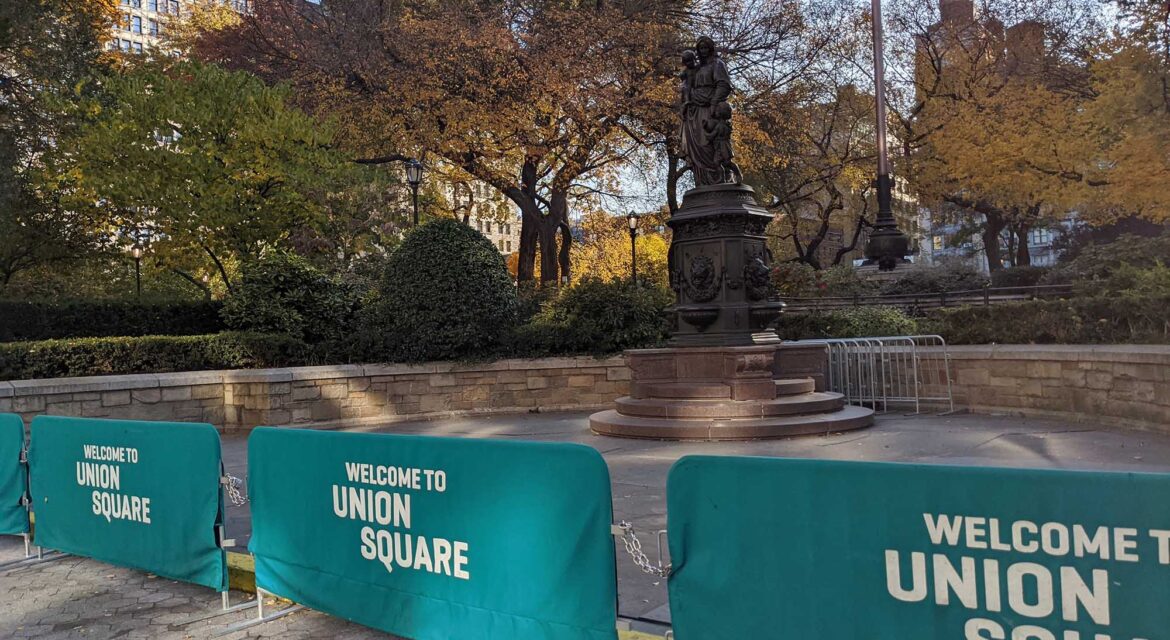 Named for the union of two of the main streets on the island of Manhattan, Union Square resides at a confluence of multiple neighborhoods in New York City. This location has cultivated the installation of many different monuments that are connected to the legacy of the city, further enabling it to become a hub of activity for the surrounding community.
Named for the union of two of the main streets on the island of Manhattan, Union Square resides at a confluence of multiple neighborhoods in New York City. This location has cultivated the installation of many different monuments that are connected to the legacy of the city, further enabling it to become a hub of activity for the surrounding community.

Creating a Community Gathering Place
 In the early 1800s, New York City Commissioners that were focused on creating a new design for the streets decided to form a square at the union of Bloomingdale Road (now Broadway) and Bowery Road (now Fourth Avenue). The location was authorized as a public place in 1831 and acquired by the City of New York in 1833. The oval design of the square was focused on a large central fountain, which was installed in 1842. Various houses, hotels, stores, banks, offices, manufacturing establishments and theatres were eventually built up around the landmark.
In the early 1800s, New York City Commissioners that were focused on creating a new design for the streets decided to form a square at the union of Bloomingdale Road (now Broadway) and Bowery Road (now Fourth Avenue). The location was authorized as a public place in 1831 and acquired by the City of New York in 1833. The oval design of the square was focused on a large central fountain, which was installed in 1842. Various houses, hotels, stores, banks, offices, manufacturing establishments and theatres were eventually built up around the landmark.
Over the decades the space went through numerous redeisgns to better serve the mass-gathering requirements of the growing city. These changes allowed it to play a central role in the first Labor Day celebration and become a hub for commerce, entertainment, and various other events. This engagement is an addition to the recreational activities that the space has encouraged.
Activity at Union Square has been further cultivated with the various monuments and areas like playgrounds that are connected to a legacy for the entire city.

The Many Monuments of Union Square

One of the most notable monuments in Union Square is the Independence Flagstaff, which commemorates the 150th anniversary of the signing of the Declaration of Independence. It features bas-reliefs and plaques of a procession of allegorical figures representing democracy and tyranny. It also has a full panel of the text of the Declaration of Independence and emblems from the original 13 colonies.
A series of 22 plaques set into the sidewalks surrounding the park are specifically connected to the legacy of Union Square itself. The Union Square Park Labor & History Plaques commemorate the square’s history from the 1600’s to 1882, when the city’s first Labor Day parade was held on the site.
Statues of George Washington, Marquis de Lafayette, Abraham Lincoln, and Mahatma Gandhi are located across Union Square, each of which has a connection to the legacy of the city and nation. Many other monuments fill and define the space, highlighting how many different ways it is connected to the community.
Playgrounds and the Union Square Cafe in the space further highlight the many ways it has become part of the community. The Union Square Partnership directly showcases this connection, as it is a community-based, non-profit organization working to ensure the best possible neighborhood for its residents, businesses, and visitors.
In 1997 the United States Department of the Interior designated Union Square Park as a National Historic Landmark because of its significance in American labor history. This significance speaks to the legacy that Union Square has embraced for the benefit of the community in a way that cultivates attention across the eras.

A Hub of Connection and Community
 The activity that Union Square has cultivated has enabled surrounding businesses to thrive and has also directly led to the creation of numerous organized and impromptu events like farmer’s markets and rallies, impacting the culture and economy of the city in a profound way. Monuments that actively embrace this legacy have further enabled it to become a hub of connection and community that benefits everyone.
The activity that Union Square has cultivated has enabled surrounding businesses to thrive and has also directly led to the creation of numerous organized and impromptu events like farmer’s markets and rallies, impacting the culture and economy of the city in a profound way. Monuments that actively embrace this legacy have further enabled it to become a hub of connection and community that benefits everyone.

